Design a shoe closet that makes getting dressed 10x easier
This is not a shopping list, it's a framework that works for you

You asked for this post a while ago—a guide to shoes. What to buy, what to wear when. And honestly, it took me a while to get here because this is a surprisingly complex topic. I didn’t want to write it until I had a clear framework for everything I think about when it comes to shoes. And now I finally do—one I’ve been testing in real life, and it’s actually working.
This post will be in two parts.
Part 1 (this one): How to build a shoe closet, and/or how to evaluate the one you already have.
Part 2 (live now): How to pick the right shoe for the outfit.
So here it goes:
Shoes are very personal. They’re emotional. And for a lot of us—myself very much included—they’re the thing we’re most likely to buy on impulse.
There’s something about shoes that bypasses logic. You see a pair, your brain does a little gasp, and before you know it, you’re justifying the purchase with things like “but it’s such a good color” or “I’ve never seen anything like it” or “what if I go to Italy next spring?” And listen, I don’t think that’s wrong. Some of my favorite shoes were bought for absolutely delusional reasons, and I have no regrets. They are like beautiful little pieces of art. But, the problem happens if your shoe closet is 50% art.
Also, if you’re reading this, you’re probably in a place where you want your shoe closet to work. Not just emotionally, but functionally. You want it to actually support your lifestyle and your outfits and not leave you in a loop of “why do I have so many shoes and still feel like none of them go?”
That’s where this post comes in.
This is not a capsule wardrobe post. I’m not going to tell you to buy a white sneaker, a black pump, a nude flat, and a loafer. Because honestly, I don’t know your life. You might hate flats. You might live in snow. You might already have five amazing pairs of shoes that you never wear and you’re just trying to figure out why.
So instead of a checklist, I want to offer you a way to think about your shoe closet—something you can build around your own life, your own style, and your own definition of what “casual” or “elevated” even means.
Let’s start at the beginning.
Step 1: What’s your life like, actually?
Before we get into style and color and silhouette, we need to talk about your reality. Like, what are you actually doing all week?
Are you walking everywhere? Driving everywhere)? Are you in meetings all day or home with a toddler or working from your couch? Do you travel? Do you live somewhere with seasons? Do you go out a lot? Or not really?
Because your life is what should shape your shoe closet.
For me, here’s what that looked like when I sat down and actually thought about it:
I need flats, mostly.
I live in LA, so I don’t need special summer or winter shoes.
I walk a lot during the day around the office but I don’t want to wear athletic shoes unless I’m working out.
I do need at least one pair of “boss mode” shoes for work trips or leading meetings.
I want to feel fancy without having to wear heels.
I don’t go to black tie events or anything super formal, so if a shoe feels like it only works in that context, it ends up sitting in the closet.
That list gave me a really honest foundation for what I actually need. So I’d encourage you to do the same. Just jot down a few sentences or bullets about your real shoe needs, based on your daily life. Not your fantasy life. Not what the fashion girlies are wearing in Copenhagen. Just you.
Action step:
Take 5 minutes and jot down what your shoe life looks like. Just a handful of bullet points is enough.
If you’re stuck, try finishing this sentence a few different ways:
“I need shoes that _______.”
“I always reach for _______.”
“I wish I had a pair of shoes that could _______.”
“I never wear _______.”
“I keep buying _______ but they don’t work because _______.”
This is the foundation everything else builds on. Now, you can break your own rules—like I said shoes are emotional—but there is power in actually knowing your pragmatic needs as you go on to the subsequent steps.
Step 2: Define what “casual” and “polished” mean to you
Okay, this part is deceptively simple but makes a huge difference. We use words like “casual” and “polished” all the time, but they’re totally subjective. What feels elevated to me might feel basic to you, and vice versa. A ballet flat might feel chill to one person and way too dressed up to someone else. Same with sneakers. Depending on how you dress and what you do all day, they could feel sporty, stylish, or completely out of place.
So before you start thinking about what you “need,” I want you to get super honest about how you define those two categories based on your real life.
Think about it like this: if you wear sneakers every day, and that’s just your reality—errands, work, commuting, whatever—then there are probably sneakers in your closet that feel casual and some that feel more polished. Maybe it’s a clean leather pair you only wear with tailored pants, or a designer collab that feels more styled than sporty. Those might go in your polished category, even though technically, they’re sneakers.
But if you’re someone who lives in pumps or loafers, then any sneaker is going to feel like a departure into casual territory. That’s just your reference point.
So that’s what I want you to pay attention to: Your reference point. What kind of shoes do you consider casual? What kind of shoes feel elevated or intentional to you?
Action step:
Jot down a few for each category. Seriously, write them down. Because once you define these on your own terms, it gets so much easier to figure out what’s working in your closet and what’s just not vibing.
Step 3: Map your shoes using the 2x2 grid
This is my favorite part. It’s like a mini diagnostic tool for your shoe wardrobe.
Once you’ve defined what casual and polished mean to you, we’re going to cross that with one more axis: the visual weight of the shoe. This is something we don’t always think about, but it has a huge effect on how an outfit feels.
Some shoes are slim and refined—like a sleek boot, a ballet flat, a simple sandal.
Others are big, chunky or substantial—like a lug sole loafer, a dad sneaker, a platform Mary Jane, a clog.
Both have their place. But if everything in your closet is slim and dainty, your outfits might always feel a little light. And if everything is heavy and clunky, you might struggle to find something that feels effortless.
So here’s the grid with some of my shoes:
Action Step: Try sorting your current shoes into this grid.
Don’t worry about getting it perfect. This isn’t a test. Infact I am pretty sure you might be looking at my grid above and thinking you will categorize things slightly differently. That is OK. It’s just a way to see where your collection is weighted—literally and visually. You might realize all your “elevated” shoes are slim, and none of them are big. Or that you have five big casual shoes but no casual shoes that feel light and airy.
This helps you get really clear on:
What you’re relying on
What you’re missing
What could make your outfits feel more balanced or more interesting
Remember the pragmatic needs we wrote down in step 1? Useful here. See, you might have a gap for polished big shoes, but if polished shoes are not a pragmatic need for you, who cares!
BONUS TIP: If you live in a place with seasons, do this activity separately for season specific shoes. I can pretty much wear boots in the summer in LA, and sandals in the winter. But remember step 1, your needs might be different. See, if you do this you might discover you only have one note shoes for the summer, but you’re all set for winter shoes.
BONUS BONUS TIP:
wrote an excellent post recently on how everyone needs weird shoes. She is right, you might or might not need WEIRD shoes specifically, but if I look at my shoe closet it is a healthy mix of pretty and ugly shoes. For example, I circled all the shoes I would categorize as ‘weird’1 here. You can look at your 2x2 matrix and identify the weird/not weird shoes.BONUS BONUS BONUS Tip: I made these in Canva Pro, here’s the template. But you don’t have to do that. Honestly you can draw a grid on paper and just write down which shoes fall where. Or you do this in real life by literally laying out your shoes on the floor. OR, do it in Indyx. Create 4 collections: Slim Casual, Slim Polished, Big Casual, Big Polished, and sort the shoes into those collections. I personally like this one a lot (along with Indyx tags) because then you could easily use color and other filters too for subsequent steps.
Step 4: Use color and mood to shift the energy
Once you’ve figured out shape and purpose, then you can layer in color.
Here’s the quick and dirty version:
Black → Adds edge
White → Adds crispness and clarity
Brown → Grounds the outfit, softens things
Metallics → Add polish, contrast, a bit of sparkle
Brights (ring 4) → Inject energy and playfulness
Muddy colors (ring 3) → Very similar to brown, will usually add grounding
Nudes → Disappear or elongate
So as a next step, you might want to look at how your shoe colors line up with the 2x2 we just walked through. For example, here is me with my black shoes.
And here my ring 3 shoes.
And no, I’m absolutely not saying you need to fill every single box with every color. I don’t. I never will. That’s not the point. This is just about seeing what you do have and what happens when certain combinations are missing.
Like, let’s say you have polished slim shoes in red, green, orange, and pink. But none in black. And then you’re wondering why you don’t have a shoe that gives you both polish and edge. That’s when something like a black pump or structured black flat could suddenly make sense. Not because it’s on a list of essentials, but because your own closet is asking for it.
What’s helpful here is just asking: what do my outfits usually need from my shoes? If your looks are already loud or dramatic, maybe what’s missing is a soft nude shoe to calm them down. If your outfits tend to be subtle or neutral, maybe what you’re craving is that one red or silver or weird color-blocked option to give things some life. And if everything you own is black? Maybe it's just time to try something that isn't, and see what it opens up.
You’re just using color (and silhouette, and mood) to shift the energy. That’s it.
Final step: Build slow. Build smart. Build for you.
The goal here is not to “complete” the grid. It’s not Pokémon.
You don’t need one shoe in every category. You might only need one new shoe, but the right one could make eight outfits work better.
What matters is that you understand what your shoes are doing. That you see what’s supporting your wardrobe and what’s just sitting there looking pretty. That you feel clear, not chaotic, when you go to get dressed.
This isn’t about becoming a minimalist, or a maximalist. Or about buying a bunch of stuff to fill in imaginary holes. It’s just about alignment.
Aligning your shoes with your actual practical + stylistic needs.
Buying decision example
You can use your own evaluation to make buying decisions. Here’s the thing, at this point I don’t NEED any more shoes. Anything I add it more emotional. But even so, how do you make decisions for example when you can't pick one of many colors available. Like I was super interested in the Christopher heel. But which color do I buy, they all look good! Let’s see, it is a slim elevated shoe. I looked at all my slim elevated shoes (side note: I tag all ‘slim’ items in
so this activity becomes super easy.)Let’s ignore all the shoes that are more casual. Now, I can easily do the squint test and see I am good on black, browns, white, muddy ring3, and greys. I mean technically I also have that one green which is a ring 4 polished slim shoe and the pepto pink, but the heart wants what it wants, and that is Christopher. So really Ochre is the one color that will add the most newness to my closet.
So evaluate your closet and share where you currently stand. Any aha moments for which shoes you overindex on? And what might be working or not working about that? I’m in your corner, and I promise I won’t tell you to buy a nude heel unless you actually want one.
PS: If you were expecting a shopping list, here are some of my faves. None of these are affiliate links or sponsored. If you enjoyed this post, the best way to support me is liking, restacking, and commenting on this post. I super appreciate your support! Anyway, my shoe go-tos:
A lot of my shoes are from Tibi. But beware, their shoe sizing is all over the place and many don’t like their quality (me included on some of the shoes).
For weird, I like Margiela tabis.
I also am a big fan of Prada shoes. They are always modern within the parameters of classic silhouettes, like these.
My fav sneaker brand is Alohas & Onitsuka.
Fav chic sandals are Kilchu. They are an Indian brand and it does take 2-3 weeks for shoes to get to the US but nothing beats them in price and quality.
If you would like any specific recs (weird ‘big’ shoes for the winter), head over to the Fit Happens chat and ask!
Next up in Part 2, we’re getting into the how. You’ve built the closet, now we figure out how to actually use it. We’ll talk about how to pick the right shoe for the outfit, based on:
silhouette and proportion
mood and contrast (how to shift the vibe of a look with just your shoe)
practical needs (walking? travel? weird weather?)
and those little “off” feelings. When everything should work, but doesn’t, and it turns out… yeah, it’s the shoes.
It’ll be part styling guide, part troubleshooting cheat sheet.
So if you’ve ever stood in front of the mirror thinking “something’s off, but I don’t know what”, this one’s for you.
The Easiest Way to Pick the Right (or Wrong) Shoe
Hallelujah—finally a series where I actually write two consecutive posts on the same topic.
There’s a reason why I didn’t use ‘mood’ as one of the dimensions for the 2x2. I don’t think there is such a thing as ‘friction’ shoes. Friction is always between two elements. So the other element (the rest of your outfit) is important to figure out if the same shoe will add friction or sameness. For example, consider sneakers. They add friction to a suit, and sameness to trackpants. We will go deeper into this topic in Part 2, don’t worry!


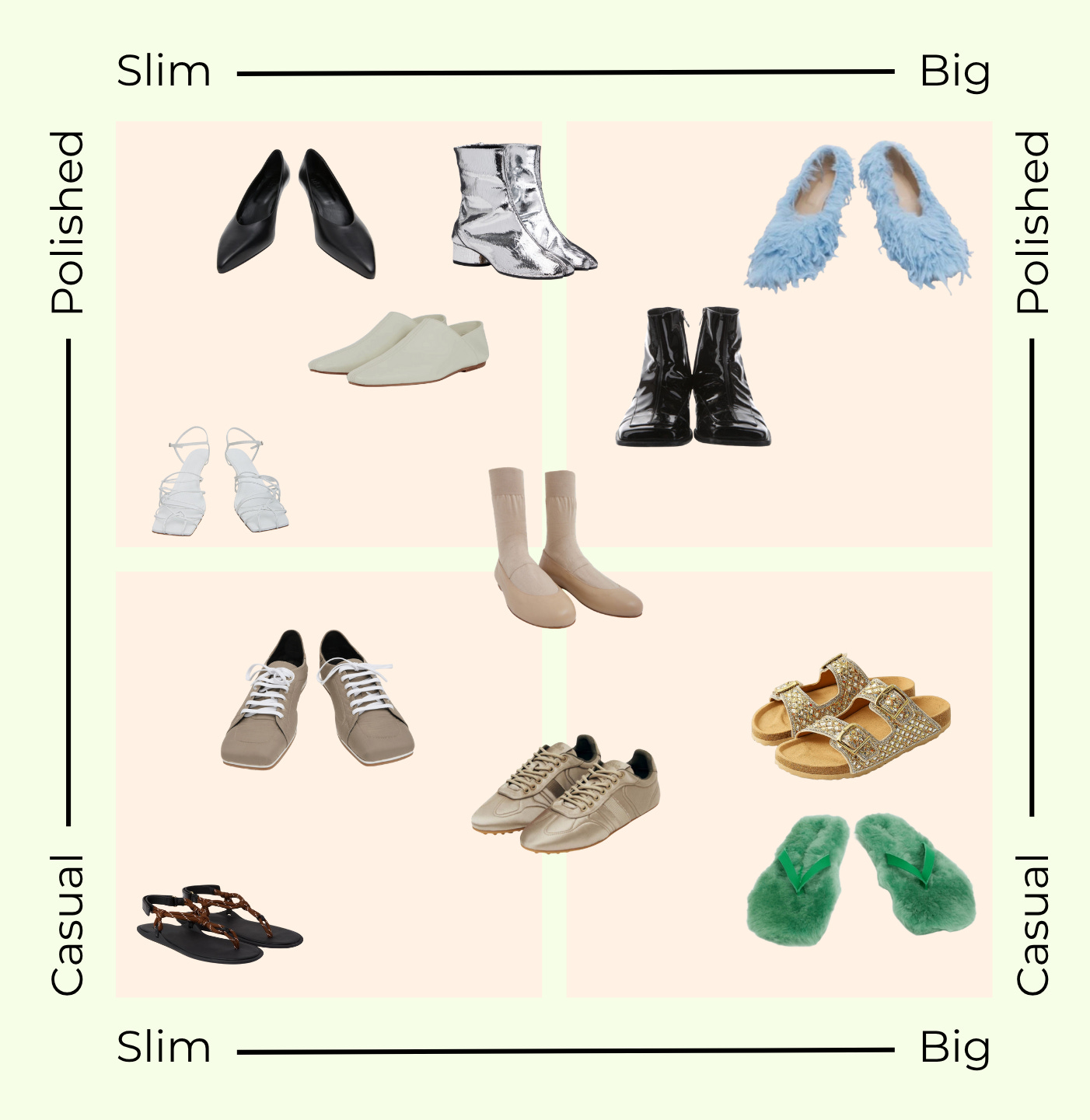
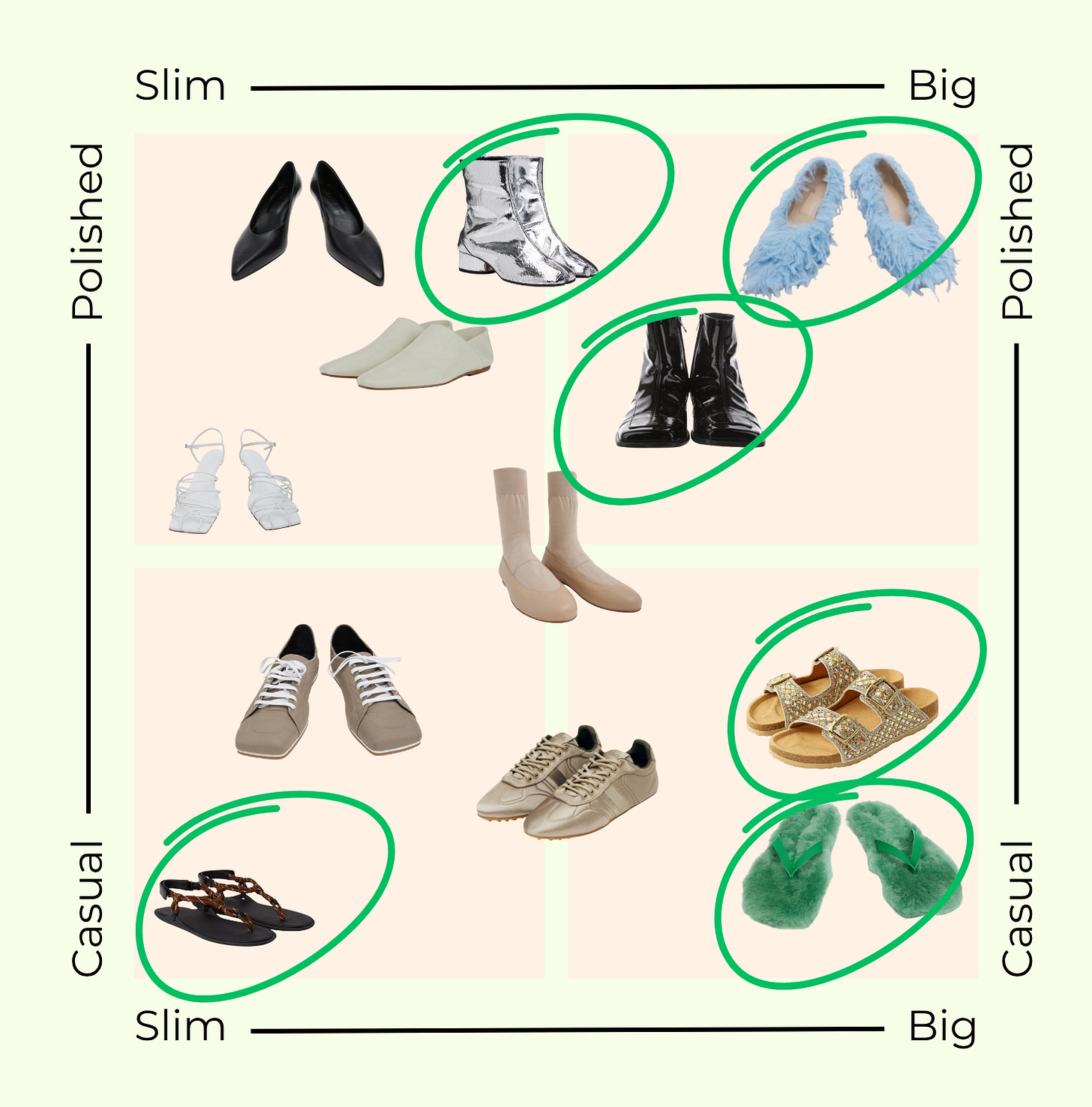
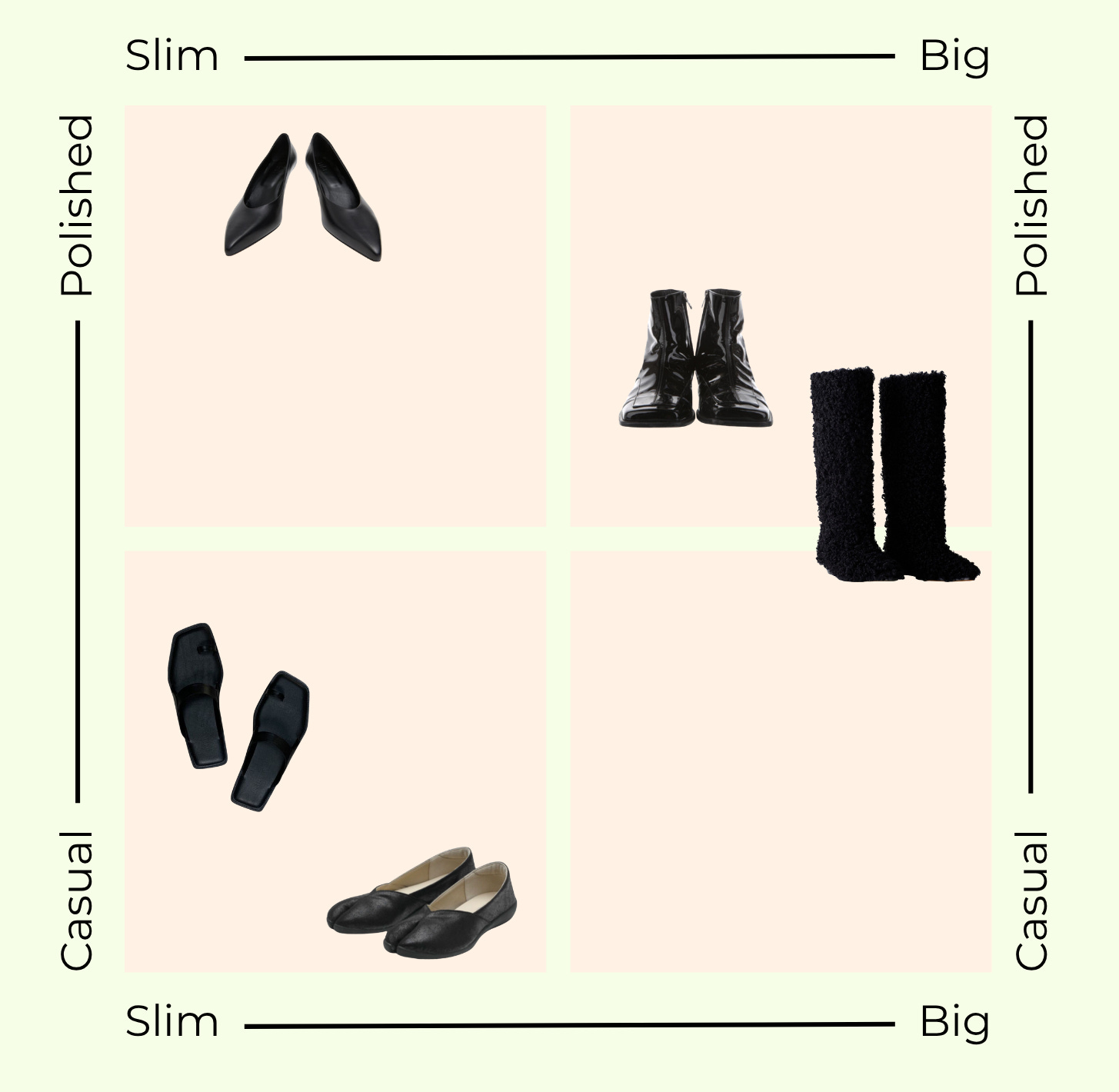
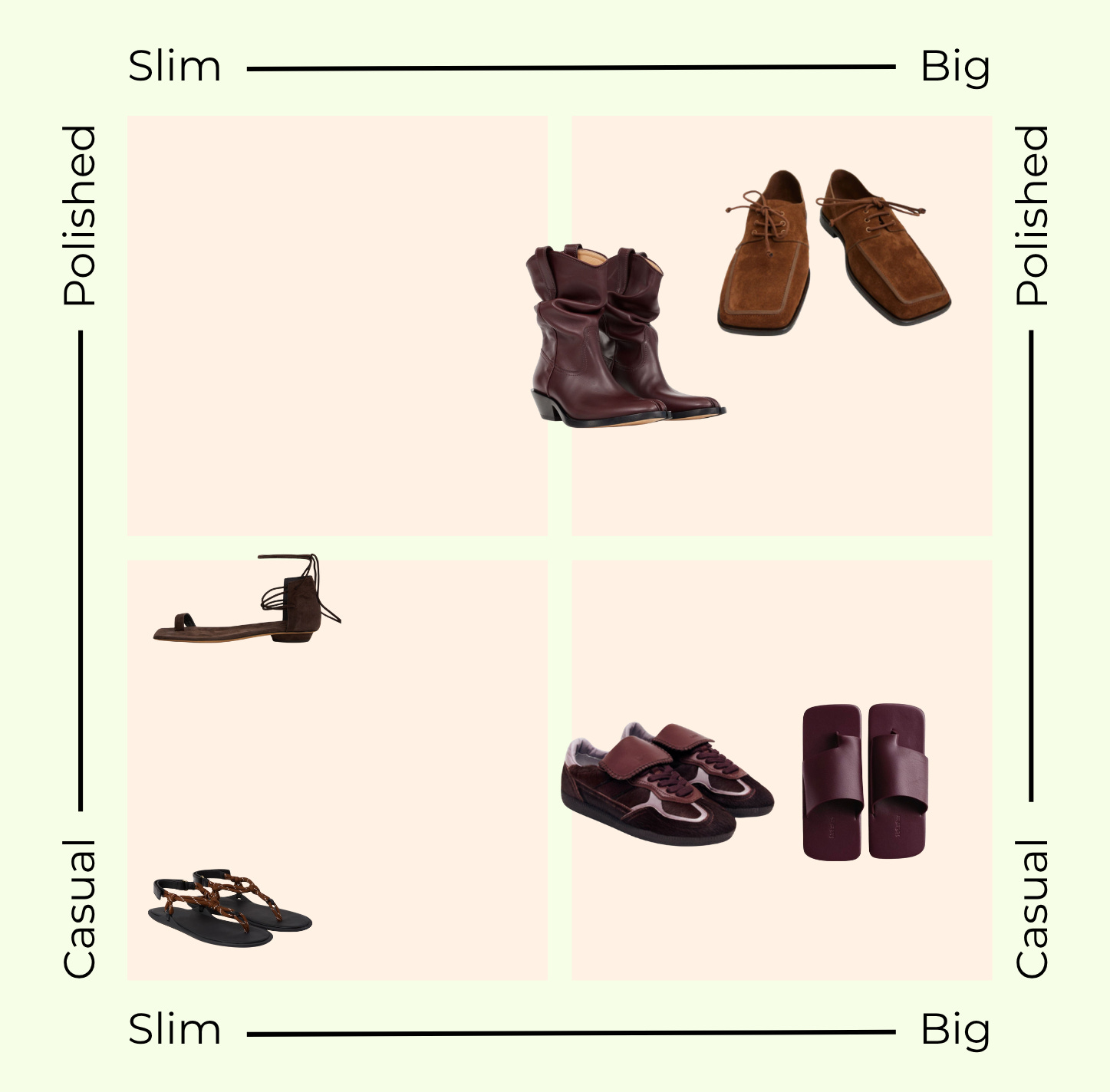
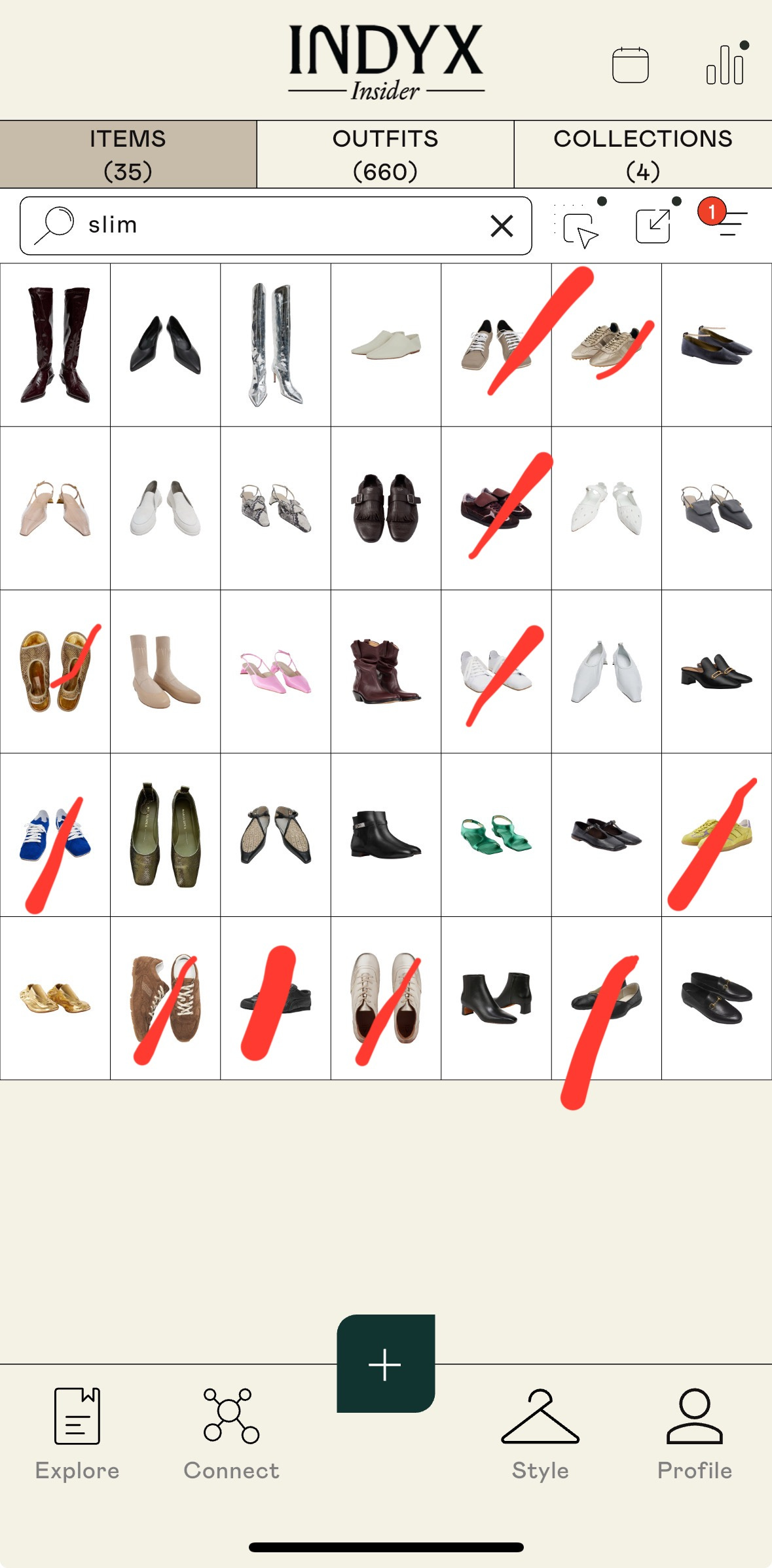
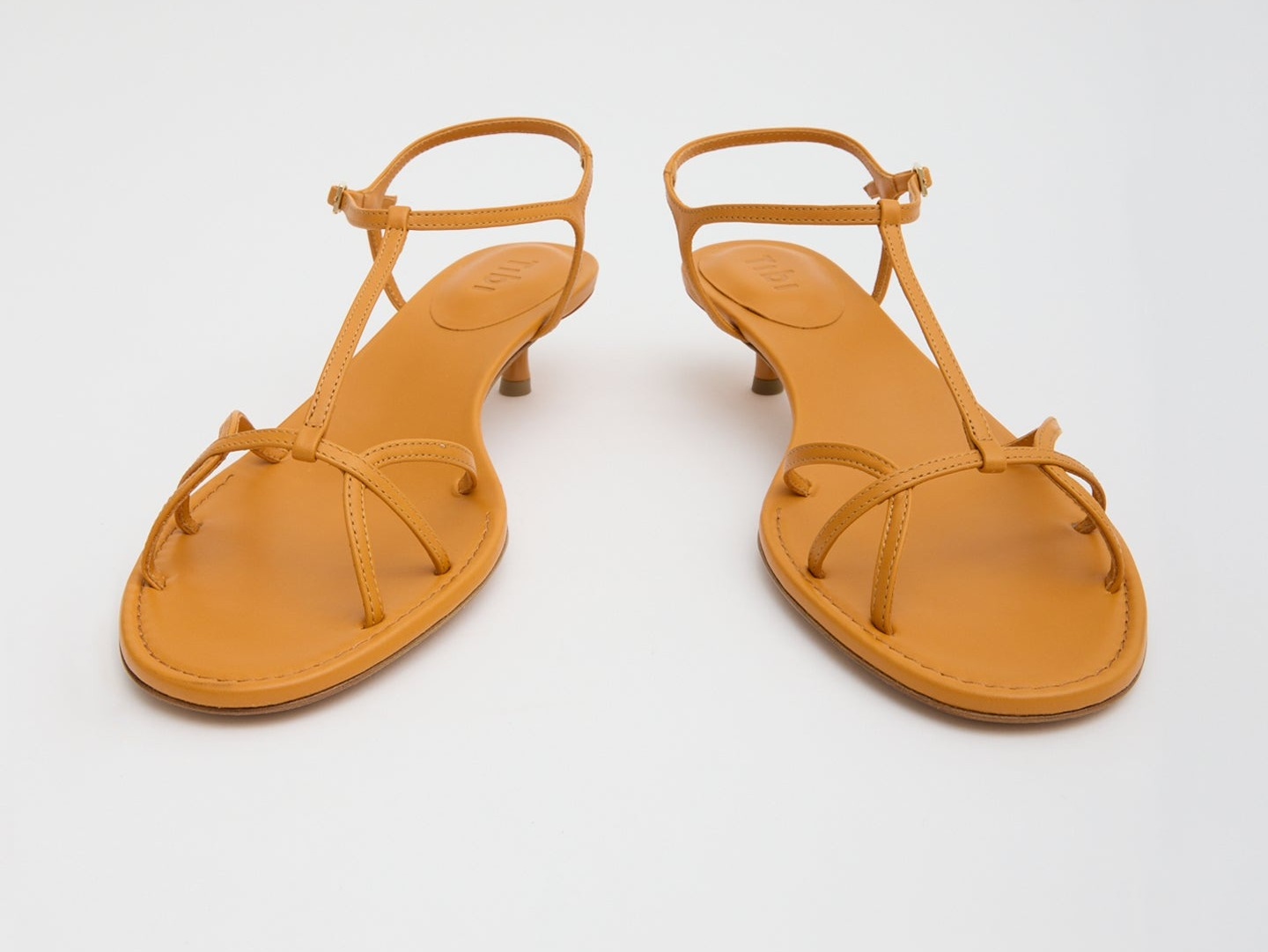


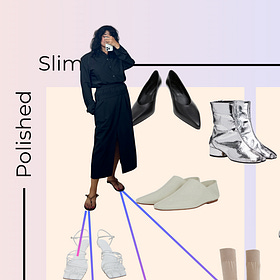
You are inventing new Indyx workflows in real time!!! We're just trying to keep up over here...and, your closet may seriously need its own case study soon lol
So so good.
What’s amazing is that if you replace the word ‘shoes’ by ‘outerwear’ we can apply your framework to figure out which coats and jackets we need in our lives. It is gonna be in our minds in the next few weeks. Weight (light/heavy), shape (slouchy/sculptural), length (short/long), vibe (casual/polished), texture (smooth/icky)… pick your 2x2! And each grid would be highly personal because tailored to our local weather throughout the year and to our own lifestyle. Maybe it would also works for bags? Because bags are emotional too? And they can be organized in the 2x2 casual/polished and slim/big.
You are a genius 😃